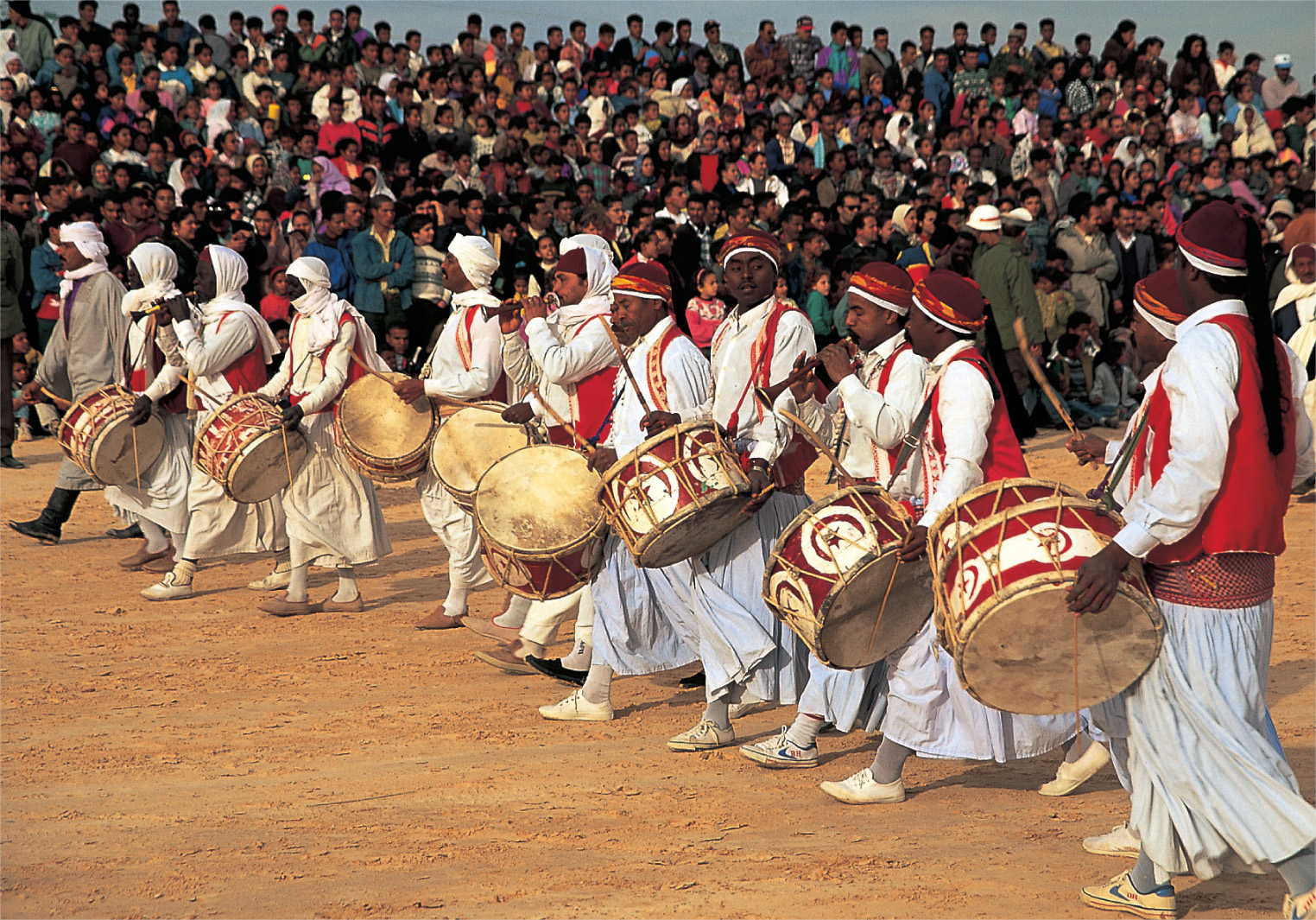38
FESTIVAL OF THE SAHARA
Douz, Tunisia
When fiercely proud Bedouin nomads and their camel caravans converge on the Tunisian oasis town of Douz for the spectacular Festival of the Sahara, sand and sparks are bound to fly. The event is still relatively unknown outside Tunisia, but with camel racing, poetry competitions, tribal plays and traditional music, this flamboyant gathering is the best desert festival for your diary.

Douz itself seems to float between the shimmering, endless dunes of the Great Eastern Erg and the mirage-making, ocean-sized salt flat of Chott El Jerid, in central Tunisia. Driving across the latter’s 50-km-wide, blinding white expanse invokes thoughts of Antarctica, and is a sure-fire way to exhaust your supply of superlatives before you even reach the oasis.
The town is the social and trading hub for five Bedouin groups, with the 15,000-strong Mrazrig tribe holding sway. During spring, many tribesmen still move their sheep and goats south towards Ksar Ghilane to graze on the Nefazaoua plains. In winter they return to Douz to work on the date harvest, and it was this seasonal regrouping that first inspired the festival (nobody really knows when it started although it has been official for over 35 years). It was a chance for tribes to test each other’s wits in games and horsemanship, a time for musical and poetical celebration, and an opportunity for youngsters to marry – a tradition that continues today.
Life for the Bedouin has always been a delicate balancing act between desert survival and oasis exuberance, a relationship mirrored in the location of H’Niche Stadium, a one-stand, open-sided affair that is site of the main action. Built on the very edge of town, it is held in place on one side by overhanging palm trees and dissolves seamlessly into wind-whipped dunes on the other.


With crowds filling the whole stadium, the festival bursts into life with the thud of drums and the piercing tones of the flute-like zoukara. The players, swathed in billowing white skirts and bright red waistcoats, their fezzes topped with lengthy black tassels, whirl like spinning tops, almost drilling themselves into the ground. Line after line of Bedouin tribesmen fire ear-cracking shotgun volleys into the sand as horse riders behind them fight to control their fiery mounts.
The most prestigious event is the camel race. With around £2000 at stake, victory must be won at any cost. In a loping version of the Olympic 800 metres, the pale-cream mehari camels – speedy sprinters normally employed to search out new pastures ahead of caravans – race shoulder to shoulder. After a series of qualifying heats, the final is on the fourth and last day, and includes two exhausting laps of the circuit. Such is the prize, it is not unknown for fights to break out between the jockeys.
In between the sporting action, an elaborate, traditional play unfolds with the Saharan dunes as a stage. It tells the story of a brave Bedouin warrior, Mandour, who falls in love with a girl from a rival tribe. Trouble and strife follow before … well, let’s not spoil the ending. Another event well worth catching is the unique ‘hair dance’. Dozens of girls, clothed in vivid dresses and with their faces veiled, kneel on the ground and swing their long hair around in great swishing arcs to the sound of hypnotic music, until they collapse.
As well as the final of the camel race, the fourth day also sees Sloughi greyhound racing, and a sand-hockey competition with the teams using shepherd’s crooks for hockey sticks. However, the most spectacular display is by acrobatic horsemen who, at full gallop, bounce around and on and off their mounts, like vaulting gymnasts. A rousing procession formally closes the festival and within hours the site is cleared. Black woollen tents are dismantled, earthenware cooking pots packed and camel trains prepared.



As the Bedouin meander through an ocean of sandy waves towards the targetless horizon, it seems that their journey home will take for ever. There is no doubt that their collective body-clock will bring them back next year, but their speedy departure suggests that their hearts belong more to the Sahara than the oasis.
the end of November or the beginning of December; the actual date is different every year. Douz is packed during the festivities, so book your accommodation early. Other events, including a ‘Miss Sahara’ competition, take place in the town in the evenings. The first day and the last day of the festival are usually the most spectacular and boisterous.
